When it comes to painting miniatures, the tool of choice for many hobbyists and professionals alike is the airbrush for miniatures. The intricate precision that an airbrush offers, thanks to its smaller needle and nozzle combo, can truly bring a miniature to life. This detailing ability of an airbrush makes it a fundamental component in your painting arsenal. However, all airbrushes are not created equal and today we’ll focus on four detailed airbrushes that stand out from the crowd: Iwata Eclipse HP-CS, Badger Patriot 105, Harder & Steenbeck Evolution, and Iwata Revolution.

The Badger Patriot 105, despite its relatively smaller nozzle size, impresses with its excellent control and responsiveness. However, it might pose a bit of a challenge when it comes to disassembly and cleaning due to its intricate small parts. On the other hand, the Iwata Revolution stands out with its high build quality, offering unique features such as a trigger stop and easy disassembly. Its spray pattern is tight and smooth, although its trigger control may need some getting used to.
The Iwata Eclipse HP-CS comes with a reputation for offering the highest level of detail among the listed airbrushes, a feature that will surely appeal to artists who prioritize precision in their work. The Badger Patriot 105, meanwhile, offers superb performance and trigger control. It stands toe to toe with the Iwata Eclipse HP-CS in terms of build quality, making it an excellent alternative for those seeking a high-performing airbrush.
Top 10 Airbrushes for Miniatures
- Iwata Eclipse HP-CS
- Badger Patriot 105 Airbrush
- Harder & Steenbeck Evolution 2-in-1 Airbrush
- Iwata Revolution
- Harder & Steenbeck Infinity CR Plus
- Badger Air-Brush Co R1V Renegade Velocity
- Gocheer Upgraded 40PSI Airbrush Kit
- Grex Genesis XGi5
- Badger Air-Brush Co. Sotar 2020-2F
- Paasche Airbrush Talon in Deluxe Wood Box Orange
One critical test of an airbrush’s performance is its ability to spray white paint, which is generally regarded as the most difficult color to work with. Each of these airbrushes faces this challenge with its unique set of features and performance characteristics. Through this article, we aim to provide you with an in-depth comparison of these airbrushes and help you make an informed decision about which one is the best fit for your miniature painting needs.
A change came about one sunny afternoon when my husband decided to surprise me with an Iwata Eclipse Hp-Cs Value Set with Hose Cleaner and Paint. An artist by hobby, I had been using a variety of airbrush sets over the years, but never had I possessed an Iwata. Hearing the commendations from fellow artists, my excitement was palpable as I unboxed this generous gift.
On first impressions, I was taken aback by the sleek design. The silver hue gleamed under the warm light of my art studio, adding a professional touch to my workspace. The overall build seemed robust and the airbrush had a good weight to it that implied quality.
Excitedly, I set to work on a new project, a scale model of a vintage car. I was thrilled to discover that the Iwata Eclipse Hp-Cs delivered a consistent and precise flow of paint, enabling me to maintain fine lines and subtle gradients effortlessly. The dual action mechanism was easy to control, giving me a new level of freedom in my work.
I was particularly impressed with the 0.35mm needle and nozzle combination. The smaller nozzle size allowed for high-detail spraying, allowing me to add intricate detailing to my model. The 1/3 ounce sized cup was generously sized and easy to clean, thanks to its funnel shape design.
Switching between different types of paint was a breeze. The airbrush handled everything from acrylic water-based paint to automotive paint, providing consistent performance across the board. The Medea Airbrush Cleaner included in the set ensured the device was always ready for the next use.
Throughout my experience with the Iwata Eclipse, the device felt stable and robust in my hand, making me confident that it could withstand long sessions in the studio. The airbrush seemed more than capable of resisting breakage thanks to its high-quality Spring-Steel needle.
However, it was not without its shortcomings. I found that the paint cup, despite being easy to clean, obstructed my view when working on smaller details. Also, a smaller sized paint cup could have been beneficial for those times when only a tiny amount of paint is needed.
- High quality build and design.
- Consistent and precise paint flow.
- Easy to clean paint cup.
- Versatile, handling different types of paints.
- Robust, capable of resisting breakage.
- Dual action mechanism easy to control.
- The size and placement of the paint cup can sometimes obstruct the view.
- A smaller paint cup option could be beneficial for smaller projects.
The moment I unpacked the Badger Air-Brush Co. Model 105 Patriot Fine Gravity Airbrush, I knew I had something special in my hands. Made of sturdy stainless steel, this instrument felt satisfyingly solid, yet expertly balanced - an ideal tool for an artist like me who spends hours on miniature and model projects.
The first thing I noticed was its finely constructed single 0.5 mm needle/nozzle, a testament to its capacity for spraying a myriad of mediums - inks, dyes, watercolors, acrylics, enamels, lacquers, and even glazes. I tested it out with some acrylics first, and the result was a smooth, even spray, demonstrating the model's fine line detail capabilities.
When it came to cleaning, I was relieved to find the process straightforward. The acute tapered color well aids faster cleaning, and the self-centering nozzle design ensures no unnecessary time wasted in adjusting. A bonus is that you can use alcohol (ISP) for cleaning without fear of deteriorating any delicate parts, as the design does not include any rubber o-rings.
One of my favorite aspects is the variety of applications the airbrush supports due to the option to change the tip and needle size. The airbrush comes with a 0.5 mm tip and needle, but for a mere $10, you can get a 0.3 mm or 0.7 mm tip and needle set. This versatility, combined with the distinct colored handles for each needle size, makes the Patriot a real workhorse in my studio.
The ergonomic design of the airbrush is another point in its favor. The standard handle is comfortable for short periods of use, but for extended use, adding the optional plastic Finger Rest made it feel even more comfortable. For artists seeking additional control, Badger also provides an optional High Hat Trigger with a longer shaft, providing better control over paint spray.
But what truly sets this product apart is the incredible customer service offered by Badger. I had a question about the airbrush, and to my surprise, I received a call from the CEO himself, eager to assist. The lifetime warranty only serves to reinforce the company's commitment to quality.
However, the Patriot is not without its downsides. While the gravity feed system reduces paint waste, it also limits the amount of paint that can be loaded at once, which might not be ideal for larger projects. Additionally, while the airbrush is ideal for beginners due to its ease of use, professionals may find its features somewhat basic compared to high-end models.
In summary, here are the pros and cons of the Badger Air-Brush Co. Model 105 Patriot Fine Gravity Airbrush:
- Versatile application with different tip and needle sizes
- Durable and sturdy stainless steel construction
- Easy to clean and maintain
- Excellent customer service and lifetime warranty
- Ergonomic design, with optional comfort-enhancing accessories
- Gravity feed system may limit paint capacity
- Might be considered basic for professional users
In conclusion, the Badger Air-Brush Co. Model 105 Patriot Fine Gravity Airbrush is an excellent investment, ideal for both beginners venturing into airbrushing miniatures and models, as well as seasoned artists looking for a reliable, easy-to-maintain tool. Its high-quality design, ease of use, and versatility make it a worthy addition to any artist’s toolkit.
As a hobbyist with a soft spot for miniatures and models, it felt like Christmas when my Harder & Steenbeck 42015 Evolution Silverline Two in One Double Action Airbrush Gun arrived at my doorstep. As an upgrade from my beginner's brush, this airbrush came highly recommended for its superior performance and sleek design.
Once the unboxing excitement had subsided, the Silverline's eye-catching metal design was what initially impressed me. Its robust build promised longevity, and the device itself had an excellent hand-feel. Its solid weight instilled confidence that I was dealing with a professional tool.
My first project was an intricately detailed dragon miniature. Loading the paint was straightforward, thanks to the conveniently included 2ml and 5ml paint cups. Equipped with 0.2mm and 0.4mm nozzles, I had flexibility over the detail level and paint volume. I appreciated how the Silverline was versatile enough to allow me to transition smoothly from broad strokes to finer details.
One of my favorite features was the colour quantity control. Being able to adjust the lever path offered precision that simplified particularly fine work. The Silverline's double-action trigger was responsive and intuitive, making it a breeze to control the air and paint mixture.
During the painting process, I noted that the airbrush handled solvent-containing paints with ease, thanks to its full-metal design. This was particularly beneficial when using the finely pigmented Elita "Life Colours" paint series, which the Silverline managed effortlessly.
Cleaning up was relatively straightforward as well. The breakdown process was easy to understand, and with a decent airbrush cleaning solution, the Silverline returned to its sparkling self in no time.
However, the Silverline was not without its cons. I noticed that the fitting to the compressor was different from my previous airbrush, requiring some additional effort and resources to get the right connection.
Here is a summary of my experience with the Harder & Steenbeck 42015 Evolution Silverline Two in One Double Action Airbrush Gun:
- High-quality, full-metal design
- Versatility with 0.2mm and 0.4mm nozzles
- Included 2ml and 5ml paint cups for flexible paint loading
- Colour quantity control for precision work
- Easily handles solvent-containing paints
- Relatively easy to clean
- The compressor fitting was not standard
- High price point, although justified by quality and performance.
Overall, despite the minor hiccup with the compressor fitting, I find the Harder & Steenbeck 42015 Evolution Silverline Two in One Double Action Airbrush Gun to be a valuable addition to my hobbyist toolkit. It is an investment piece that delivers outstanding performance and precision, taking my miniature and model painting to a new level of detail and refinement.
Let me paint you a picture. It was a calm Saturday afternoon. The birds chirping outside my window, my favorite playlist softly playing in the background, and my Iwata - Revolution Cr Airbrush (4247) waiting patiently on my table. A new Warhammer miniature stood on my workbench, ready for its transformation.
As I picked up the airbrush, the first thing that struck me was the sheer weight and quality of the tool. It wasn't heavy, but it had an undeniable solidity to it, the kind that speaks of robust construction and durability. As I held the chrome beast, it fit naturally into my grip - its fine ergonomics making it feel like an extension of my own hand.
Drawing from my collection of Vallejo paints, I prepared to breathe life into my miniature. I found the .5 needle of the airbrush ideal for my task. It was brilliant at providing a broader spray pattern that could efficiently cover larger sections of my model without sacrificing the quality of the application.
I took a deep breath and pressed the trigger. I was met with a steady, consistent stream of paint. It was just as the reviews had promised - precise, smooth, and oh-so-satisfying. Each pass layered the miniature with a uniform coat, the intricacies of the model beautifully preserved.
Later, as I delved into finer details, I lamented the absence of a trigger limiter adjustment on the handle. It was a feature I'd come to appreciate on my Tamiya airbrush. But, as fate would have it, the handle was interchangeable, and I could swap them out, making my Iwata just as versatile as any of my other tools.
Cleaning up was a breeze. The airbrush dismantled easily and was straightforward to clean, a critical aspect to maintain its performance over time.
Now, as I look upon my finished model, the blend of colors singing praises of a job well done, I couldn't help but feel a sense of satisfaction. My Iwata - Revolution Cr Airbrush (4247) had proven itself a worthy addition to my arsenal.
- Excellent build quality, solid and durable.
- Good ergonomics make it comfortable to use for extended periods.
- .5 needle provides a broad spray pattern, suitable for larger sections of models.
- Smooth, consistent paint application.
- Easy to clean, maintaining its performance over time.
- Interchangeable handle allows for additional features to be added.
- Does not come with a trigger limiter adjustment on the handle. This feature is great for precise work but can be mitigated with an interchangeable handle from another Iwata airbrush.
- Price may be a deterrent for beginners, but the investment pays off in the long run with its superior performance and durability.
- May require additional tools or accessories for highly detailed work.
I remember the day I finally decided to upgrade my model and miniature painting tools. My finger hovered over the "Buy Now" button, my heart pulsing with a strange blend of excitement and trepidation. But after deep contemplation, I plunged in and ordered the Harder & Steenbeck Infinity CR Plus 2in1 Airbrush. The cost was on the higher side, but the glowing reviews convinced me that this was an investment worth making.
A week later, a beautifully packed package arrived at my doorstep. As I unboxed the airbrush, it felt like unveiling a piece of jewelry. Nestled in a black velvet-lined case, the airbrush was a marvel of craftsmanship, with gold-plated accents and a red anodized aluminum handle that gleamed under the light.
The first time I held it, I marveled at the balance and the slim yet firm body of the tool. The Infinity CR Plus had a comforting heft that assured me of its quality. It was equipped with a 1/8" male quick disconnect, designed to connect and disconnect multiple airbrushes at the air hose instead of the compressor. This feature made it easy for me to switch between different airbrushes effortlessly.
I first tried the 0.15 mm nozzle for a detailed miniature painting project I was working on. The floating nozzle design was self-centering, and it was a breeze to field strip the brush without any special tools. The detailed work came out with astonishing precision that was leaps and bounds beyond what my previous tools could achieve. I then switched to the 0.4 mm nozzle for a larger model painting job. The transition was smooth, and I appreciated the versatility of the airbrush.
With its Teflon-made gaskets, the airbrush was impressively resistant to all types of paints and lacquers. The needle guards were incredibly helpful for fine detail work, protecting the needle tip while offering an unobstructed view of my work. And the pre-set handle's click-on functionality made it easy to return to specific settings.
However, it wasn't all rosy. The 0.15 mm and 0.2 mm nozzles were too fine for more substantial model painting. The airbrush quickly clogged with the more viscous paint, requiring frequent cleaning during my work. The needles also felt a bit soft, and I had to be extra cautious not to damage the tips.
In summary, here are the pros and cons of my experience:
- Impeccable fit and finish.
- Excellent balance and comfort.
- Easy to connect and disconnect from the air hose.
- Self-centering floating nozzle design.
- Highly versatile with interchangeable nozzles.
- Teflon gaskets provide high solvent resistance.
- Needle guards are useful for fine detail work.
- Pre-set handle allows easy return to specific settings.
- The finer nozzles clog easily with more viscous paint.
- Needles can be easily damaged if not handled carefully.
I'll never forget the day my Badger Air-Brush Co R1V Renegade Velocity Gravity Feed Airbrush arrived at my doorstep. I carefully opened the box and inside, cradled within a sturdy black plastic case, was the masterpiece. My heart pounded with excitement as I took the airbrush into my hand, feeling its cold, metallic touch. The build quality was exquisite - robust, balanced, and precisely constructed.
Over the next months, my workroom became my sanctuary. The Renegade Velocity became an extension of my arm, an instrument that transformed my artistic vision into reality. I found myself losing track of hours as I worked on my miniatures, the intricate details coming to life under the skilled guidance of my airbrush.
The very first time I loaded it with paint and pressed the trigger, the R1V delivered a silky, flawless spray. The Gravity Feed system made it incredibly easy to control the flow of paint, which was a godsend when working on my intricate models. The ‘smartcenter’ nozzle, true to its name, ensured absolute precision in needle/nozzle alignment and spray performance. This feature, coupled with the ‘point perfect carbide polished needles, added another level of control and allowed me to produce crisper fine lines than ever before.
One of the things I appreciated most was the robustness of the R1V. As the months passed, the airbrush never faltered, handling continuous, almost daily, use with grace and reliability. I’ve accidentally left paint in it overnight on multiple occasions, but even then, the cleaning was relatively easy, thanks to the simple construction and durable materials.
Despite its many perks, the Badger R1V is not without its flaws. The one major challenge was mastering the ‘tensionsense’ trigger assembly, which required quite a bit of time and patience to get used to. Also, for those who frequently change colors, the cleaning process might seem a bit tedious.
- Exceptional control and precision in spraying
- Robust and durable construction
- Highly versatile - it can spray a hairline to a 1-inch pattern
- Easy to maintain and clean
- Learning curve for mastering the trigger assembly
- Color changing can be time-consuming due to cleaning
In the end, the Badger Air-Brush Co R1V Renegade Velocity Gravity Feed Airbrush was a brilliant addition to my toolkit. It elevated my craftsmanship and allowed me to take my miniature model painting to new levels of detail and precision. The benefits far outweighed the minor inconveniences, making the R1V a worthy investment for any artist seeking to push the boundaries of their work.
As I gingerly unboxed the Gocheer Upgraded 40PSI Airbrush Kit, the anticipation of its promised capabilities hummed in my hands. It looked sophisticated, coming in a sleek black color, projecting an aura of professional craftsmanship. The kit was compact, but don't be fooled by its size; the powerful compressor and double-action airbrush signaled promise of high-level performance.
From the moment I fired up the compressor, I felt a surge of power as the air pressure swelled up to 40PSI, an upgrade from other kits I've used before. My first project was to breathe life into a bland miniature model that had been gathering dust on my shelf. Loading the airbrush with paint was a breeze, thanks to the dual-action airbrush gun. With the press of a trigger, I was able to control both the air and pigment volume, a feature that proved incredibly useful for fine detailing.
The airbrush proved to be an absolute workhorse, delivering a performance increase of a whopping 60%. I was painting for hours, and yet it never faltered. The 0.2 and 0.5mm nozzle options were an added bonus, allowing me to switch between fine detail spray and broader background sprays. It was a joy to have such versatility at my fingertips.
Over the course of several projects, I realized that this was more than just an airbrush kit; it was a tool that brought my creations to life. From cake decorations to nail design, the Gocheer Airbrush Kit showcased its versatility. The included cleaning kit made maintenance a breeze, prolonging the kit's lifespan and ensuring that my tools were always in top-notch condition.
However, it wasn't all sunshine and rainbows. While the Gocheer airbrush kit does a lot right, a few things could be improved. The screw threads for connecting the gun to the compressor didn't seem durable enough for regular wear and tear. To remedy this, I bought a set of quick-connect adapters, which made disassembly and cleaning much easier. Also, while the kit comes with a detailed instruction manual, I feel there is a slight learning curve, especially for beginners. Nevertheless, with some patience and practice, one can quickly become adept at operating it.
- Powerful 40PSI airbrush kit, superior to many others on the market.
- Dual-action airbrush provides excellent control over fluid and pigment volume.
- Versatile and can be used for a wide variety of applications.
- Comes with a professional cleaning kit, ensuring the airbrush gun is maintained well.
- High-quality performance and reliability even after prolonged use.
- The screw threads for connecting the gun to the compressor could be more durable.
- There is a learning curve for beginners, and it might take some time to master the tool.
In summary, my experience with the Gocheer Upgraded 40PSI Airbrush Kit has been largely positive. Despite a couple of minor drawbacks, its power, versatility, and endurance make it an excellent investment for both novices and veteran artists alike.
My Journey with the Grex Genesis XGi5 0.5mm Nozzle Top Feed
There I was, my latest miniature model sitting in front of me, a fresh canvas awaiting my creative touch. It was time to embark on a new project, and I had the perfect companion for the task - the Grex Genesis XGi5 0.5mm Nozzle Top Feed airbrush.
The moment I held the airbrush, it felt like an extension of my own hand, thanks to its ergonomic grip, a patented design by Grex. With its sleek heavy nickel chrome-plated housing and gravity-fed system, it looked as robust as it was stylish. I was ready to take my miniature painting to a whole new level.
Using it for the first time was an absolute joy. The airbrush offered cutting-edge precision, a factor I couldn't help but marvel at as the fine atomized mist settled smoothly onto my model. I could effortlessly control the flow of paint with the preset adjustment knob, which came in handy for detailed work.
One feature that set the Grex Genesis XGi5 apart was the Quick-Fit needle caps. These were not only simple to set up and remove but also cleverly stored in the rear handle for quick access. It was details like this that made the airbrush feel intuitive and user-friendly.
Moreover, the airbrush came with three different reservoirs, allowing me to choose the ideal cup size for my project. The inline top-mount design ensured balanced handling of the airbrush, while the integrated paint cup was super easy to clean.
Switching between different nozzle sizes was also a breeze with the Grex Genesis XGi5. I found this particularly useful when I wanted to vary the paint spray patterns or work on different types of models.
However, it wasn't all smooth sailing. A slight hiccup I encountered was the delicate nature of the needles. They were quite easy to bend, requiring me to handle them with extra care. I would recommend having spare needles on hand, just in case.
Now, after several months of use, I must say, the Grex Genesis XGi5 0.5mm Nozzle Top Feed has truly won me over. It combines top-end quality with comfort and adaptability, all for a very reasonable price.
- Superior ergonomic design for enhanced comfort and handling.
- Precise control for fine detailed work.
- Quick-Fit needle caps for easy setup and removal.
- Variety of cup sizes for versatile applications.
- Easy to clean and maintain.
- Needles are fragile and easily bent.
- Requires careful handling to prevent damage to delicate parts.
Despite its minor drawback, the Grex Genesis XGi5 remains my favorite airbrush to date. It has redefined my experience with miniature painting, and I look forward to many more creative sessions with it.
From the moment I first held the Badger Air-Brush Co. Sotar 2020-2F in my hands, I was captivated. Its glossy black exterior shimmered under the studio lights, and the weight of the device felt balanced and professional in my grip. I had heard positive things about this product, and I was eager to put it through its paces.
My first project was a set of intricately detailed fantasy miniatures, and the Sotar was an absolute game-changer. Thanks to its large gravity feed and fine nozzle, I was able to paint precise details with astounding accuracy. The "hair" line spray pattern allowed me to add delicate shading and intricate designs to the miniatures, which previously would have been a struggle with other airbrushes.
As an artist who tends to work on extended projects, I was impressed by the Sotar's 1/12 ounce color cup. It meant I could work for longer periods without needing to refill, allowing me to stay focused on the intricacies of my project.
The micrometer setting was another standout feature. The ability to preset my desired spray pattern led to a more consistent and professional finish. Furthermore, the dual action, internal mix system provided excellent control and fine atomization of paint.
However, while the Sotar 2020-2F is an excellent product, it's not without its shortcomings. The most noticeable issue was the difficulty in cleaning it. While not impossible, it did take a bit longer than expected to thoroughly clean the device after use. Also, compared to some other airbrushes on the market, the Sotar might seem a bit pricey. However, given its performance, I found the price to be justified.
In conclusion, here's a list of the pros and cons:
- Large gravity feed allows for extended use before refilling
- Fine nozzle and "hair" line spray pattern allows for precision work
- Micrometer setting for presetting desired spray pattern
- Dual action, internal mix system offers excellent control and atomization
- Requires more effort to clean after use
- Might be considered pricey compared to other options
Overall, the Badger Air-Brush Co. Sotar 2020-2F exceeded my expectations. Despite its minor flaws, the Sotar 2020-2F’s high level of precision and easy handling make it an excellent choice for any artist looking to take their miniature and model work to the next level.
My journey with the Paasche Airbrush Talon Gravity Feed Airbrush started when I received the finely crafted wooden box it was delivered in. Upon opening the box, I was greeted with an exquisite piece of machinery, looking more like an item of jewellery than a tool for crafting miniatures. The chrome-plated body of the airbrush shone in the light, and the anodized aluminium handle was cool to the touch. Made in the USA, the quality was evident from the very beginning.
As I started to use the airbrush, I immediately noticed the double-action functionality that offered a level of control that I hadn't previously experienced. The trigger was responsive and precise, enabling me to control the air and paint flow seamlessly. The three head sizes (.25mm, .38mm, .66mm) allowed me to achieve patterns from a hairline to a broad 3 inches. The fan aircap came in especially handy when I was painting larger models, allowing me to cover larger areas evenly.
The gravity feed system was a game-changer. The design minimized paint waste and made switching colors a breeze. It also made the airbrush easier to clean than my previous siphon-feed models. All I had to do was spray through my paint cleaner, wipe off the needle and it was ready for the next use.
One particular model that I was working on, a detailed dragon figurine, really showcased the airbrush's capabilities. I was able to create incredibly fine details on the scales, and seamlessly transition between colors. The PTFE packing handled both water and solvent-based paints beautifully, allowing me to mix mediums without issue.
However, it wasn't all sunshine and roses. The needle seemed somewhat delicate, especially the largest one. I had to be extremely careful when cleaning and changing them out, as they felt like they could bend or break with too much pressure.
Also, initially, the trigger did stick occasionally, but after reaching out to Paasche's customer service, they advised me to lubricate it lightly. This rectified the issue and I had no further problems with it.
- High-quality construction and materials
- Great level of control and precision
- Ability to handle both water and solvent-based paints
- Gravity feed system reduces paint waste and makes cleaning easier
- Exceptional customer service from Paasche
- Needles can feel delicate and require careful handling
- Initial stickiness with the trigger, which can be resolved with light lubrication.
Overall, the Paasche Airbrush Talon Gravity Feed Airbrush has revolutionized my experience with painting miniatures and models. The level of detail I can achieve, the ease of use, and the superb customer service have made this a staple in my crafting arsenal.
Beginner’s Guide
Let’s get down to business and chat about the essential elements of our hobby – tools, techniques, and, of course, safety.
Tools
Oh, the joy of tools! They’re our best friends in this world of miniatures, models, and fantastical figures. Let’s have a look at the essentials.
- Modeling Knife: A good old modeling knife is a must-have. It’s perfect for cutting, trimming, and ensuring those tiny details are just right.
- Pliers: A small set of pliers is fantastic for bending metal parts or getting a good grip on stubborn pieces.
- Files: Miniature files are great for smoothing down rough edges or shaping small details.
- Tweezers: A set of tweezers is a life-saver for placing those tiny, tricky components.
- Glue: We can’t forget about good quality model glue. Always look for ones that don’t leave residue and are strong enough to hold your model together.
- Airbrush: Ah, the beloved airbrush. We’ll talk about this in depth in the Airbrush section, but for now, let’s just say that an airbrush can be your best pal when it comes to painting.
- Brushes: Different sizes for different needs. We use these for detail work that airbrushes might not handle as well.
Techniques
Building and painting miniatures isn’t just about the tools, it’s about the techniques too! Here’s a quick rundown of what we’ll cover:
- Preparation: Cleaning, trimming, and priming the model.
- Assembly: Carefully piecing together your miniature or model.
- Painting: We’ll get into the fun part – base coating, layering, detailing, and finishing!
Safety
And, because we’re responsible hobbyists, let’s briefly touch on safety:
- Always cut away from yourself when using sharp tools.
- Wear protective eyewear when necessary, especially when cutting or filing.
- Use non-toxic paints where possible and always paint in a well-ventilated area.
- Always keep your workspace clean and organized to avoid accidents.
Airbrushes
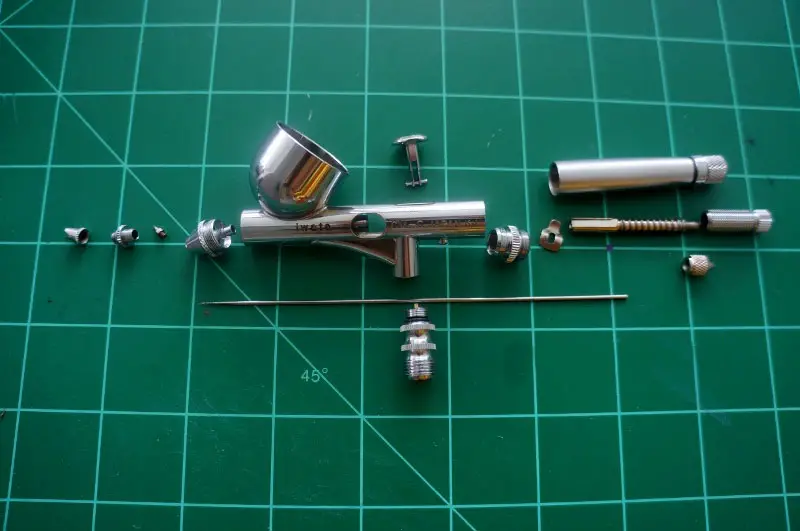
Alright, folks, it’s time to talk about a favorite topic of mine – airbrushes. If you’ve ever worked with miniatures or models, you know how important it is to get that perfect finish, and trust me, an airbrush can be your best ally here.
Airbrushes, my friends, are nothing short of magical tools when it comes to painting miniatures and models. They can apply paint in smooth, even layers, creating a finish that’s often difficult to achieve with regular brushes. Plus, airbrushes allow us to play with gradients and transitions between colors, making our miniatures look extra lifelike.
Types
Airbrushes come in different shapes and sizes, but there are two primary types that you’ll commonly see:
- Single-action Airbrushes: Simpler and easier to use. When you press the trigger, you’ll get a fixed ratio of air and paint. Good for large areas and basic work, but not as flexible for detailed work.
- Dual-action Airbrushes: These give you greater control. Press the trigger down for air, pull it back for paint. This allows you to adjust the paint flow on the fly, making them ideal for detailed work.
Nozzle sizes
| Airbrush Type | Nozzle Size (mm) | Application | Remarks |
|---|---|---|---|
| Single-Action | 0.2 – 0.5 | Basic coloring | Easy to use |
| Double-Action | 0.2 – 0.5 | Detail work | Greater control |
| Trigger | 0.2 – 0.5 | Large surfaces | Ease of use for longer periods |
| Mini/Micro | 0.15 – 0.2 | Ultra detail | Requires precise control |
| Siphon Feed | 0.3 – 0.5 | Large surfaces | Easier color switching |
| Gravity Feed | 0.2 – 0.5 | Detail work | Better paint flow |
| Side Feed | 0.2 – 0.5 | Flexibility | Can change angle of color cup |
| Large Nozzle | 0.5 – 0.8 | Broad coverage | Good for large-scale projects |
| Medium Nozzle | 0.3 – 0.5 | General use | Versatile |
| Fine Nozzle | 0.15 – 0.3 | Detail work | Precision, detailed work |
Choosing an Airbrush
Choosing an airbrush is like choosing a wand in the world of Harry Potter – it should be a good match for you! Consider the following:
- Purpose: Are you painting large models or working on tiny, detailed miniatures? Dual-action airbrushes might be better for detailed work, while single-action ones can handle larger tasks.
- Comfort: An airbrush should feel good in your hand. You’ll be using it for extended periods, so comfort is key.
- Budget: Airbrushes vary in price. Start with a budget-friendly option if you’re new, and as you get more into it, you can consider investing in a high-end model.
- Cleaning: Look for an airbrush that’s easy to clean. As we work with different paint colors, cleaning becomes a significant part of the process.
Advanced Techniques
Let’s dive into the advanced side of things! Once you’ve mastered the basics, it’s time to up your game. From assembling to painting and detailing, there’s a whole world of techniques waiting for you to explore.
Assembling
When it comes to advanced assembly, patience is key. Here are a few things to consider:
- Dry Fitting: Before gluing anything, it’s always a good idea to dry fit your pieces. This allows you to make sure everything lines up correctly.
- Alignment Tools: For complex models, alignment tools can be a real lifesaver. They ensure pieces fit together perfectly.
- Pin Vise and Wire: For those really delicate or heavy pieces, consider pinning. This involves drilling holes in both pieces and connecting them with a wire for extra strength.
Painting
Let’s talk about the art of painting. Sure, base coating is important, but there’s so much more we can do!
- Layering: This involves applying several thin layers of paint to create smooth transitions between colors.
- Washing: Washing is a technique where a thin, dark paint (a wash) is applied over a lighter color. It settles in the recesses and around details, giving depth to your model.
- Dry Brushing: Dry brushing involves taking a dry brush with a little bit of paint and lightly brushing over the model. It picks up the raised details, making them pop.
Detailing
Finally, let’s discuss detailing. This is where your model really comes to life.
- Weathering: To give your model a lived-in look, consider weathering techniques. This might involve adding scratches, rust, or dust effects.
- Decals: Decals can add extra detail to your model. They’re tricky but can really make a model stand out with a professional finish.
- Finishing Touches: Finally, consider adding finishing touches like a varnish to protect your paint job, or a base to display your model.
Remember, practice makes perfect. Don’t be afraid to try new techniques, and most importantly, have fun with it!
How To Choose The Best Airbrush Kit
Choosing the best airbrush kit for miniatures involves evaluating several key factors to ensure it fits your needs, preferences, and budget. Here’s a step-by-step guide to help you make the right choice:
Determine Your Needs
First, you need to determine what you’ll primarily be using the airbrush for. Are you focusing on large scale models or smaller, detailed miniatures? For general purpose model painting, a nozzle size of around 0.3mm is a good starting point.
Single-Action or Dual-Action
Decide between single-action and dual-action airbrushes. Single-action airbrushes are easier to use and good for basic work, but dual-action airbrushes give you more control over the paint flow, which can be beneficial for detailed work on miniatures.
Gravity-Feed or Siphon-Feed
Airbrushes also come in gravity-feed and siphon-feed versions. Gravity-feed airbrushes have a paint cup on top and require less air pressure, allowing for more precise application and less wasted paint. They’re often the preferred choice for painting miniatures.
Consider the Complete Kit
When looking at airbrush kits, also consider what else comes in the package. You’ll need a compressor, and it’s handy if the kit includes cleaning supplies and a range of paint colors to get you started. However, if you’re already set up with these, you might just need the airbrush itself.
Price and Quality
Airbrush kits range widely in price. As a beginner, it might be tempting to go for a very cheap kit, but remember that you often get what you pay for. Mid-range kits usually offer a good balance between price and quality.
Reviews and Recommendations
Lastly, always check out user reviews before making your final decision. See what other miniature painters are saying about the airbrush kit you’re considering. Look at both the positive and negative reviews to get a comprehensive understanding of the product.
Remember, the best airbrush kit for you is the one that meets your specific needs, fits your budget, and feels comfortable in your hand.
Conclusion
In conclusion, each airbrush – the Iwata Eclipse HP-CS, the Badger Patriot 105 Airbrush, and the Harder & Steenbeck Evolution 2-in-1 – brings distinct attributes to the table that serve a range of artistic needs. The Iwata Eclipse HP-CS stands out for its high-quality design, dual action mechanism, and versatility. The Badger Patriot 105 is an all-around workhorse with customizable options, sturdy build, and superior customer service. The Harder & Steenbeck Evolution 2-in-1 impresses with its full-metal design, precision work capabilities, and effective handling of solvent-containing paints.
Choosing the right airbrush depends largely on individual needs, budgets, and preferences. All three models offer value for money, but with slight differences in their features, designs, and performance. Prospective buyers should carefully consider the strengths and shortcomings of each model as outlined in this article. From professional-grade precision offered by Iwata Eclipse HP-CS, the versatility and customer service championed by Badger Patriot 105, to the sophisticated design and functionality of Harder & Steenbeck Evolution 2-in-1, there’s an airbrush to suit every artist’s demand.
FAQ
What is the best airbrush for miniatures?
The Master Airbrush Airbrushing System Kit is recommended for beginners, as it provides a cost-effective all-in-one system, including a compressor and three different airbrushes with varying nozzle sizes and feed types. For advanced painters, the Iwata Eclipse Hp Cs is highly recommended due to its exceptional quality and versatility, and for professional users on a budget, the Badger Air Brush Patriot is a great option.
What should I consider when choosing an airbrush for miniatures?
Key factors to consider include the type of paint and air mixing, the size and kind of nozzle, the connection dimensions, the feed type, the size of the cup, control type, and pressure. The recommended nozzle size for finely detailed work is between 0.15mm and 0.25mm, while 0.3mm to 0.5mm should suffice for general miniature painting. A double-action airbrush is recommended, and a good pressure for painting miniatures is between 15-35 PSI1.
What are the different types of feed for airbrushes?
There are three basic types of feed: gravity, siphon, and side feed. Gravity feed is recommended for miniatures, as it provides more control.
What is a good airbrush for detailed work?
The Iwata Eclipse Hp Cs with a 0.35mm nozzle is ideal for detailed work.
What is a good budget-friendly airbrush for miniatures?
The Badger Air Brush Patriot is a great budget-friendly option for professional users.
What is a good airbrush for a variety of artistic crafts?
The Paasche Airbrush TG is a versatile dual-action airbrush suitable for various artistic crafts.

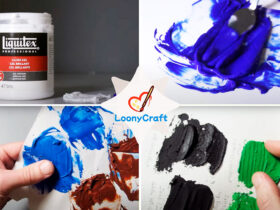

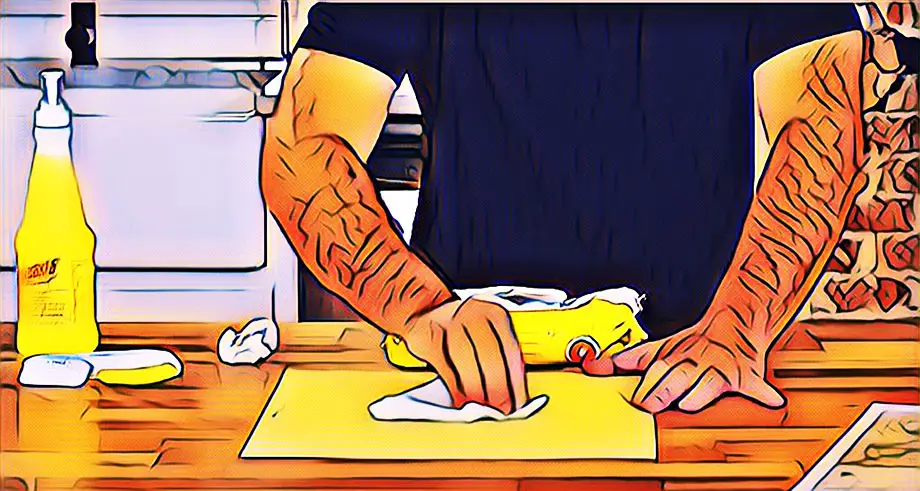
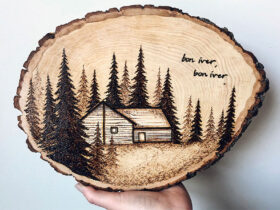
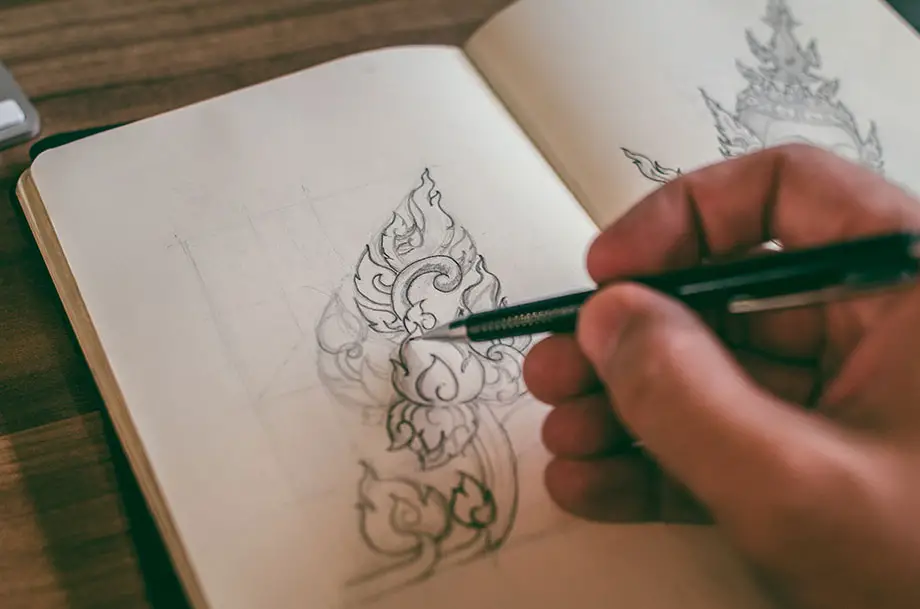
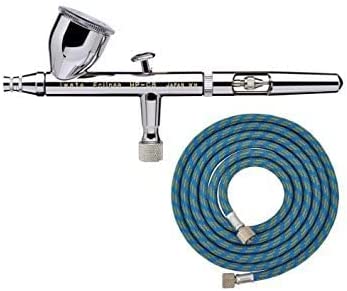
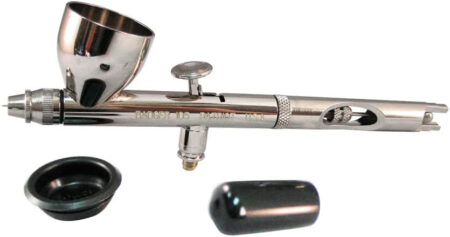
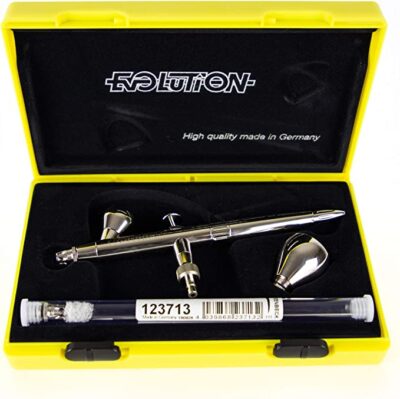
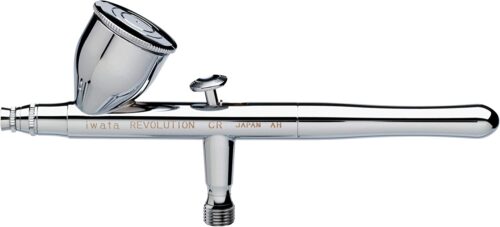
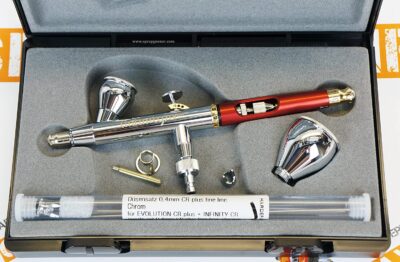
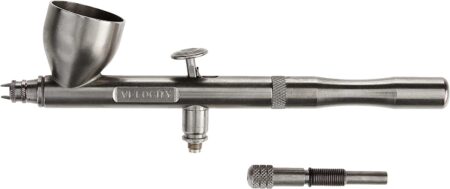
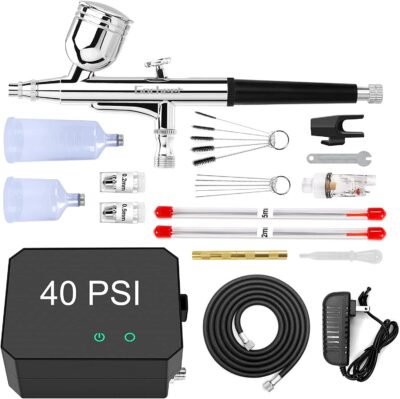
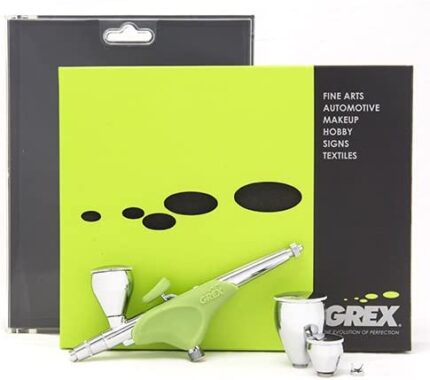

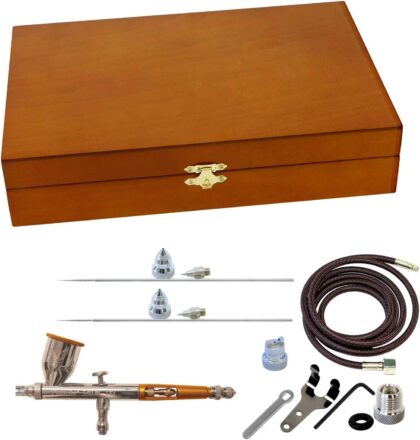

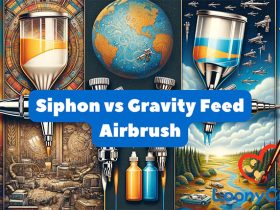
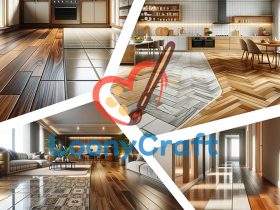
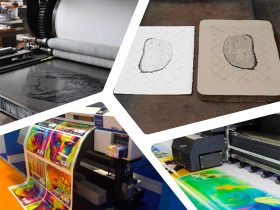


Leave a Reply